Search the Special Collections and Archives Portal
Search Results
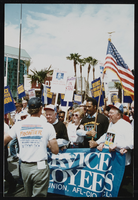
Frontier Strike: Jesse Jackson, Culinary Union, Las Vegas (Nev.), 1992 April 21 (folder 13 of 13), image 22
Date
1992-04-21
Description
Arrangement note: Series I. Demonstrations, Subseries I.A. Frontier Strike
Image

Frontier Strike rally with the service employees unions, Culinary Union, Las Vegas (Nev.), 1992 April 21 (folder 1 of 2), image 22
Date
1992-04-21
Description
Arrangement note: Series I. Demonstrations, Subseries I.A. Frontier Strike
Image

Circus Circus food truck, Frontier Strike, Culinary Union, Las Vegas (Nev.), 1992 July 13 (folder 1 of 2), image 22
Date
1992-07-13
Description
Arrangement note: Series I. Demonstrations, Subseries I.A. Frontier Strike
Image
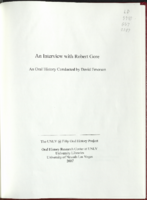
Transcript of interview with Robert Gore by David Emerson, January 31, 2008
Date
2008-01-31
Archival Collection
Description
Robert Gore first came to Las Vegas in 1973 as a public affairs officer with the Air Force. He returned to West Virginia to go into the family business in 1976 and four years later was offered a job with Summa Corporation. Back in Las Vegas, he also served as director of the Air Force Association. At a dinner meeting of the Association, Retired General Bill Becker suggested that an engineering school was needed at UNLV. Bob and the Air Force Association put together a group called FORGE, whose primary purpose was to promote a school of engineering. Bob Gore, Dave Broxterman, John Heilman and others began researching the idea of building an engineering school. They drew the interest of people at the Test Site, Nellis Air Force Base, and PEPCON, and put together a slide show and a binder full of research data. Bob and Dave presented their information to the Nevada Development Authority and Nevada legislators, and started a grassroots campaign to enlist the support of the people of Nevada. Bob gives details on the efforts that FORGE and many other individuals made on behalf of the engineering school. He takes readers into the myriad meetings that were held and the important associations that were forged with people like Tom Beam Lawrence Livermore Laboratories, the DOE, Jim Cashman, Mary Hausch of the Las Vegas Review Journal, Channel 3, Bob Thomas, and numerous others. The interviewer, Dr. David Emerson, was involved in this effort as well, and shares anecdotes concerning donations from a mining company and Reynolds Electrical and Engineering Company. Today Bob is working with a real estate company in Las Vegas. Twenty-some years later, he still recalls the hard work and dedication of people like Benet Stout, on loan from Senator Chic Hecht's staff, the legislators who unanimously cosponsored the bill initiating the building project, and the original FORGE group who gave their all to the idea of a school of engineering at UNLV.
Text
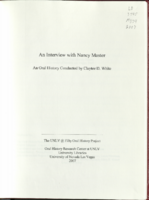
Transcript of interview with Nancy Master by Claytee D. White, July 14, 2006
Date
2006-07-14
Archival Collection
Description
Nancy Master grew up in a little town called Greenville in Western Michigan. Her dad was in middle management at a refrigerator company and her mother was a librarian and a teacher. Nancy and her two sisters experienced an idyllic childhood, climbing trees, riding bikes, and swimming in Baldwin Lake. School and church were important activities in Nancy's life. When she first went to college, she was sent to Michigan Girls' State, but switched to the Michigan State campus and found that she liked that much better. During the summer of 1967, Nancy and some friends got involved in the Civil Rights Movement. They went to Mississippi to teach and ended up experiencing an intimidating visit from the KKK. Nancy taught school in Jackson, Michigan, and also continued with her own schooling. She took time off to work on her dissertation and was eventually hired to teach history at University of Wisconsin. Since there were so few openings for history teachers, she decided to take a library degree. She and her husband Larry and their daughter came to Las Vegas in 1980 at the suggestion of Nancy's uncle, a doctor who had established a practice here. Larry was hired at Roy Martin Junior High, and in February of 1981, Nancy was hired to teach library skills classes at UNLV. When Nancy first came to UNLV, she worked the reference desk. She became interested in faculty politics and was soon on the senate. She served on the executive committee under Bill Marchant, Sheryl Bowles, and others. Eventually she took over the chair position herself. These days Nancy works with the history and political science colleges. She does some teaching and proctors for students taking UNR classes on the UNLV campus. Her outreach community work includes Habitat for Humanity and mentoring projects for children-in-poverty. Nancy considers UNLV the great love of her life, after her family.
Text
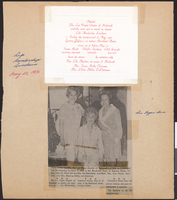
Clinton Wright, Remembering 1 October, and The Great Pause: Las Vegas Chronicles of the Covid-19 project files, 2013 to 2020
Level of Description
File
Archival Collection
Barbara Tabach Papers
To request this item in person:
Collection Number: MS-01101
Collection Name: Barbara Tabach Papers
Box/Folder: Box 04
Collection Name: Barbara Tabach Papers
Box/Folder: Box 04
Archival Component

Transcript of interview with Gladys Neville by JoAnn Bingham, June 2, 2004
Date
2004-06-02
Description
Gladys Neville's story begins in Crowley, Louisiana, in 1915. She grew up as one of eleven children, graduated from high school in 1933, and entered nursing school at Charity Hospital in New Orleans. After earning her RN in 1937, she continued to work at Charity for four years, then joined the Army and served in the European Theater for three years. Gladys details her experience in nursing school, explaining that students were given on-the-job training. With that training and four years of nursing after that, she was well qualified to join the 24th General Hospital overseas deployment in WWII. It was during her stay in Florence, Italy, that she was married and not too long after that, the war ended and she and her husband were transferred back to the States. Her husband's work for Bank of America took them to Laguna Beach, Salt Lake City, and Idaho Falls. Their children were bom during this period and Gladys took a 20 year hiatus from nursing. In 1962 they moved to Las Vegas and in 1964 Gladys decided to take a refresher course at Southern Nevada Memorial Hospital (now University Medical Center). After that refresher course, Gladys was hired for a full-time day shift at UMC. She and the interviewer share many details about the hospital's physical appearance, the staffing, location of surgeries and burn units, and how the RN's encouraged LPN's to continue their training and become nurses. Gladys concludes her interview with further recollections of her military nursing experience. She also gives more details about her war-time wedding. Among her final comments, she mentions the stress of working full time when her husband was ill.
Text

Transcript of interview with Herb Jeffries by Cork Procter, May 5, 2009
Date
2004-05-05
Archival Collection
Description
Herb Jeffries, a renaissance man, loved life and lived it well. A consummate professional, Jeffries excelled as a singer, actor, businessman, and lover of the finer things in life. He appreciated good literature, art, culturally-diverse food selections, freedom, and worthwhile conversation. The pioneering black singing cowboy, was born Umberto Valentino in Detroit, Michigan on September 24, 1913. His career as an entertainer began as a teenager in Chicago, singing with Earl “Fatha” Hines. Next came the movie career and then back to the stage in 1939 with the Duke Ellington Orchestra. By the early 1950s, he had moved to France and opened a popular jazz club in Paris and another in southern France. According to this interview, these clubs drew “beautiful people” from all over the world. Jeffries’ career moved from performances in the American South restricted to tobacco warehouse and black-only movies theatres to starring in numerous movies leading ultimately to a star on the Hollywood Walk of Fame. The most famous of his five wives was Tempest Storm the burlesque star and motion picture actress. Herb Jeffries made his transition, leaving behind his fifth wife, at 100 years of age on May 25, 2014.
Text
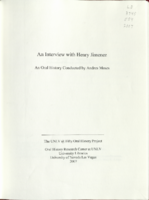
Transcript of interview with Henry Jimenez by Andres Moses, May 23, 2006
Date
2006-05-23
Archival Collection
Description
Henry Jiminez was born in Torrance, California, in 1985. His family lived in Long Beach until he was 13, with the exception of six months spent in Mexico. They moved to Las Vegas and bought a home here in July of 1998. Henry completed middle school and high school in Las Vegas. In his freshman year, he got involved in student government, played basketball and tennis, and was in the Key Club and the Latino Club. He earned a high enough GPA to get the Millennium Scholarship. When he arrived at UNLV, Henry continued with his interest in campus politics, joined the first Latino fraternity, and developed an interest in women's studies. He was a senator for 2 years and took over the chairmanship of the Ways and Means Committee at one point. He served on many other committees and made time in his busy schedule to attend as many student organization meetings as he could. Henry graduated in May of 2006 and immediately left to intern in Washington, D.C., with Senator Harry Reid. His other goals included studying for the LSAT, and eventually entering law school.
Text
Pagination
Refine my results
Content Type
Creator or Contributor
Subject
Archival Collection
Digital Project
Resource Type
Year
Material Type
Place
Language
Records Classification
